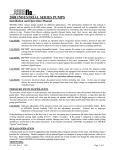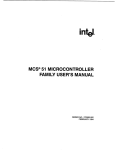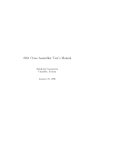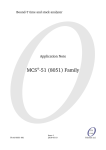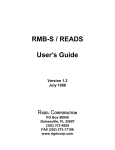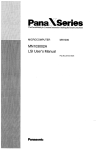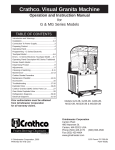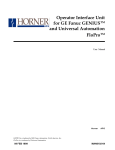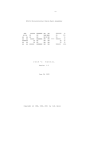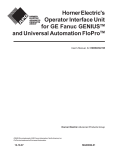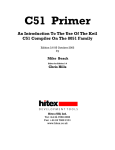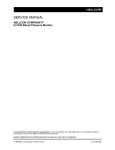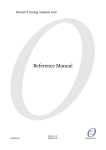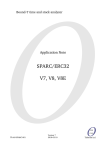Download MCS-51 (8051) Family, issue 1, March 2001 - Bound
Transcript
Bound-T Application Note MCS-51 (8051) Family Version 1 March 2001 Space Systems Finland Ltd www.ssf.fi Kappelitie 6 FIN-02200 ESPOO Finland This document was written at Space Systems Finland Ltd. by Ville Sipinen. The document is currently maintained by the same person(s). Copyright 2001 Space Systems Finland Ltd. This document can be copied and distributed freely, in any format, provided that it is kept entire, with no deletions, insertions or changes, and that this copyright notice is included, prominently displayed, and made applicable to all copies. Document reference: Document issue: Document issue date: Bound-T version: Web location: Trademarks: CWT-SSF-MA-002 Draft March 2001 1 none Bound-T Application Note 8051 iii Preface The information in this document is believed to be complete and accurate when the document is issued. However, Space Systems Finland Ltd. reserves the right to make future changes in the technical specifications of the product Bound-T described here. For the most recent version of this document, please refer to the web address http://www.ssf.fi/boundty/. If you have comments or questions on this document or the product, they are welcome via electronic mail to the address [email protected], or via telephone, fax or ordinary mail to the address given below. Please note that our office is located in the time-zone GMT + 2 hours, and office hours are 9:00 -16:00 local time. Cordially, Space Systems Finland Ltd. Telephone: Fax: Web: +358 9 6132 8600 +358 9 6132 8699 http://www.ssf.fi http://www.ssf.fi/boundty/ Mail: Kappelitie 6 FIN-02200 ESPOO Finland NOTICE FOR PRELIMINARY DOCUMENT VERSION: Notwithstanding the above preface, the present version of this document is entirely preliminary and distributed for your information only. The distribution of this document shall not be understood as placing Space Systems Finland (SSF) under any obligation to create or supply a product of the type described here. SSF is developing this product with the support of the European Space Agency and others, but SSF has no obligations to other parties with respect to this development. March 2001 Preface Bound-T Application Note 8051 iv This page is blank on purpose Preface March 2001 Bound-T Application Note 8051 v CONTENTS Chapter 1 1.1 Purpose and Scope . . . . . . . . . . . . . . . . . . . . . . . . . . . . . . . . . . . . . . . . . . . . . . . . 1 1.2 Overview . . . . . . . . . . . . . . . . . . . . . . . . . . . . . . . . . . . . . . . . . . . . . . . . . . . . . . . . 1 1.3 References . . . . . . . . . . . . . . . . . . . . . . . . . . . . . . . . . . . . . . . . . . . . . . . . . . . . . . . 2 1.4 Abbreviations and Acronyms . . . . . . . . . . . . . . . . . . . . . . . . . . . . . . . . . . . . . . . . . 2 Chapter 2 The 8051 and Timing Analysis 2.1 The 8051 . . . . . . . . . . . . . . . . . . . . . . . . . . . . . . . . . . . . . . . . . . . . . . . . . . . . . . . . 3 2.2 Static Execution Time Analysis on the 8051 . . . . . . . . . . . . . . . . . . . . . . . . . . . . . 3 Chapter 3 Supported MCS(R)-51 (8051) Family Features 3.1 Overview . . . . . . . . . . . . . . . . . . . . . . . . . . . . . . . . . . . . . . . . . . . . . . . . . . . . . . . . 4 3.2 Levels of Support . . . . . . . . . . . . . . . . . . . . . . . . . . . . . . . . . . . . . . . . . . . . . . . . . . 5 3.3 Implications of Limited Support . . . . . . . . . . . . . . . . . . . . . . . . . . . . . . . . . . . . . . . 6 3.4 Reminder of Generic Limitations . . . . . . . . . . . . . . . . . . . . . . . . . . . . . . . . . . . . . . 7 3.5 Support Synopsis . . . . . . . . . . . . . . . . . . . . . . . . . . . . . . . . . . . . . . . . . . . . . . . . . . 7 3.6 Registers and Memory Accesses. . . . . . . . . . . . . . . . . . . . . . . . . . . . . . . . . . . . . . 9 3.7 Keil C-51 Calling Protocol . . . . . . . . . . . . . . . . . . . . . . . . . . . . . . . . . . . . . . . . . . . 9 3.8 Instructions . . . . . . . . . . . . . . . . . . . . . . . . . . . . . . . . . . . . . . . . . . . . . . . . . . . . . . 10 3.9 Time Approximations . . . . . . . . . . . . . . . . . . . . . . . . . . . . . . . . . . . . . . . . . . . . . . 11 Chapter 4 Using Bound-T 8051 4.1 Input Formats . . . . . . . . . . . . . . . . . . . . . . . . . . . . . . . . . . . . . . . . . . . . . . . . . . . . 12 4.2 Command Arguments and Options . . . . . . . . . . . . . . . . . . . . . . . . . . . . . . . . . . . 12 4.3 The Keil Library Routines . . . . . . . . . . . . . . . . . . . . . . . . . . . . . . . . . . . . . . . . . . . 13 4.4 Analysing Programs that Use RTX-51 . . . . . . . . . . . . . . . . . . . . . . . . . . . . . . . . . 13 4.5 HRT Analysis . . . . . . . . . . . . . . . . . . . . . . . . . . . . . . . . . . . . . . . . . . . . . . . . . . . . 13 4.6 Choice of Calling Protocol . . . . . . . . . . . . . . . . . . . . . . . . . . . . . . . . . . . . . . . . . . 14 4.7 Basic Output Format Limitations . . . . . . . . . . . . . . . . . . . . . . . . . . . . . . . . . . . . . 14 4.8 Warning Messages. . . . . . . . . . . . . . . . . . . . . . . . . . . . . . . . . . . . . . . . . . . . . . . . 14 4.9 Error Messages . . . . . . . . . . . . . . . . . . . . . . . . . . . . . . . . . . . . . . . . . . . . . . . . . . 15 4.10 Output of Option “-trace effect”. . . . . . . . . . . . . . . . . . . . . . . . . . . . . . . . . . . . . . . 17 Chapter 5 March 2001 Introduction Writing Assertions 5.1 Using Scopes . . . . . . . . . . . . . . . . . . . . . . . . . . . . . . . . . . . . . . . . . . . . . . . . . . . . 19 5.2 Naming C Subprograms. . . . . . . . . . . . . . . . . . . . . . . . . . . . . . . . . . . . . . . . . . . . 19 5.3 Naming Assembler Subprograms . . . . . . . . . . . . . . . . . . . . . . . . . . . . . . . . . . . . 19 5.4 Naming C Variables . . . . . . . . . . . . . . . . . . . . . . . . . . . . . . . . . . . . . . . . . . . . . . . 19 Table of Contents Bound-T Application Note 8051 vi 5.5 Naming Assembler Variables . . . . . . . . . . . . . . . . . . . . . . . . . . . . . . . . . . . . . . . . 20 5.6 Specifying Variable and Subprogram Addresses. . . . . . . . . . . . . . . . . . . . . . . . . 20 5.7 Properties . . . . . . . . . . . . . . . . . . . . . . . . . . . . . . . . . . . . . . . . . . . . . . . . . . . . . . . 20 Appendix A: Table of Contents Variant Support 21 March 2001 Bound-T Application Note 8051 vii LIST OF TABLES Table 1: Definition Analysis vs Arithmetic Analysis . . . . . . . . . . . . . . . . . . . . . . . . . . . . . . . . 5 Table 2: Generic Limitations of Bound-T. . . . . . . . . . . . . . . . . . . . . . . . . . . . . . . . . . . . . . . . . 7 Table 3: Synopsis of 8051 Support . . . . . . . . . . . . . . . . . . . . . . . . . . . . . . . . . . . . . . . . . . . . . . 8 Table 4: Support of 8051 variants . . . . . . . . . . . . . . . . . . . . . . . . . . . . . . . . . . . . . . . . . . . . . . 21 March 2001 List of Tables Bound-T Application Note 8051 viii This page is blank on purpose List of Tables March 2001 Bound-T Application Note 8051 1 Introduction 1.1 Purpose and Scope 1 Bound-T is a tool for computing bounds on the worst-case execution time of realtime programs; see reference [1]. There are different versions of Bound-T for different target processors. This Application Note supplements the Bound-T User Manual [1] by giving additional information and advice on using Bound-T for one particular target processor family, the Intel MCS(R)-51 (8051) Family. Some information in Chapters 4 and 5 of this Application Note applies only when the target-program executable is generated with the Keil 8051 C-compiler or assembler. This information could have been the subject of an independent Application Note but was included here because the Keil tools are very commonly used for this processor family. 1.2 Overview The reader is assumed to be familiar with the general principles and usage of BoundT, as described in the Bound-T User Manual [1]. The user manual also contains a glossary of terms, many of which will be used in this Application Note. In a nutshell, here is how Bound-T bounds the worst-case execution time (WCET) of a subprogram: Starting from the executable, binary form of the program, Bound-T decodes the machine instructions, constructs the control-flow graph, identifies loops, and (partially) interprets the arithmetic operations to find the “loop-counter” variables that control the loops, such as n in “for (n = 1; n < 20; n++) { ... }”. By comparing the initial value, step and limit value of the loop-counter variables, Bound-T computes an upper bound on the number of times each loop is repeated. Combining the loop-repetition bounds with the execution times of the subprogram’s instructions gives an upper bound on the worst-case execution time of the whole subprogram. This Application Note explains how Bound-T has been adapted to the architecture of the MCS(R)-51 (8051) Family processors and how to use Bound-T to analyse programs for these processors. To make full use of this information, the reader should be familiar with the register set and instruction set of this processor, as presented in reference [2]. The remainder of this Application Note is structured as follows: • Chapter 2 describes the main features of the 8051 architecture and how they relate to the functions of Bound-T. • Chapter 3 defines in detail the set of 8051 instructions and registers that is supported by Bound-T. March 2001 Bound-T Application Note 8051 2 1.3 1.4 • Chapter 4 explains those Bound-T command arguments and options that are wholly specific to the 8051 processors or that have a specific interpretation for these processors. • Chapter 5 addresses the user-defined assertions on target program behaviour and explains the possibilities and limitations in the context of the 8051. References [1] Bound-T User Manual. Space Systems Finland Ltd., Doc.ref. DET-SSF-MA-001. [2] 8-bit Embedded Controller Handbook. Intel 1990 [3] C51 Compiler User’s Guide 01.97 Keil Software Inc Abbreviations and Acronyms See also reference [1] for abbreviations specific to Bound-T and reference [2] for the mnemonic operation codes and register names of the MCS(R)-51 (8051) Family. Effort Describes the execution time of an instruction in processing cycles and the number of memory reads and writes performed by it. LSB Least Significant Byte MSB Most significant Byte Scope Presents the context of an object of the program (for example when name only is not sufficient) WCET Worst-Case Execution Time March 2001 Bound-T Application Note 8051 2 The 8051 and Timing Analysis 2.1 The 8051 3 The 8051 [2] is an 8-bit micro-controller. It has a “Harvard” architecture (separated program and data memories). Instructions can be 8, 16 or 24 bits wide. Data can also be read from the program memory. Data memory is divided into internal and external with respect to the processor. All accesses to the program memory and external data memory are addressed indirectly with dedicated registers defining the actual address. All arithmetic integer operations are supported in hardware, but floating point operations are not supported at all. No standard floating point type is defined. An on-chip stack in the internal data memory contains the return addresses from subroutines and data pushed by PUSH instructions. Since the internal memory is at most 256 bytes, and includes the banked registers (see section 3.6), the stack must be less than 256 bytes. 2.2 Static Execution Time Analysis on the 8051 The 8051 architecture is very regular and quite fitting for static analysis by Bound-T. Instruction timing in no case depends on the data being processed, but only on the control flow. The automatic analysis of the loop counters is limited to unsigned 8-bit computation (see section 3.1). March 2001 Bound-T Application Note 8051 4 3 Supported MCS(R)-51 (8051) Family Features 3.1 Overview This section specifies which 8051 instructions, registers and status flags are supported by Bound-T. We will first describe the extent of support in general terms, with exceptions listed later. Note that in addition to the specific limitations concerning the 8051, Bound-T also has generic limitations as described in the User Manual [1]. For reference, these are briefly listed in section 3.4. General support level In general, when Bound-T is analysing a target program for the 8051, it can decode and correctly time all instructions. Bound-T can construct the control-flow graphs and call-graphs for all instructions, unless they contain unresolved jumps to dynamically defined destinations. When analysing loops to find the loop-counter variables, Bound-T is able to track all the 8-bit additions and subtractions assuming unsigned variables. Bound-T correctly detects when this integer computation is overridden by other computations, such as multiplications in the same registers. However there is one considerable limitation specific to 8051 processors: they don’t have any dedicated machine instructions to handle signed numbers and cannot for example directly compare signed numbers. Because of this limitation the program code processing signed integers often contains operations which Bound-T 8051 cannot support at arithmetic level (see section 3.2) and therefore automatic loop bounding is possible only if loop counters and limits are unsigned 8-bit numbers. However counter steps can be positive or negative. Furthermore because all registers (except the data pointer) are 8 bits wide and all arithmetic operations are performed with 8-bit entities, the processing of bigger variables requires several arithmetic operations to several registers or memory locations. Currently Bound-T does not understand that these operations actually process single variables and cannot find and bound loop counters that are bigger than 8-bit variables. In ‘C’ terms loop counters should to be “unsigned char”. Loops with signed counters or 16-bit or larger counters can be bounded only by usergiven assertions. Before detailing the exceptions to the general support, some terminology needs to be defined concerning the levels of support. March 2001 Bound-T Application Note 8051 3.2 5 Levels of Support Four levels of support can be distinguished, corresponding to the four levels of analysis used by Bound-T: 1. Instruction decoding: are all instructions correctly recognised and decoded? Is the execution time of each instruction correctly and exactly included in the WCET, or only approximately? 2. Control-flow analysis: are all jump and call instructions correctly traced to their possible destinations? Are there other instructions that could affect control flow, and are they correctly decoded and entered in the control-flow graph? 3. Definition analysis: does Bound-T correctly trace the effect of each instruction on the data flow, in terms of which “cells” (registers, memory locations) are defined (written, modified) by the instruction? 4. Arithmetic analysis: to what extent are the arithmetic operations of instructions mastered, so that the range of the results can be bounded? These levels are hierarchical in the sense that a feature is considered to be supported at one level only if it is also supported at all the lower levels, with arithmetic analysis as the highest level. Opaque values When an operation is supported at the definition level, but not at the arithmetic level, then Bound-T’s arithmetic analysis considers the operation’s results to be “unknown” or opaque. When an opaque value is stored in a register or memory location, the store is understood to destroy the earlier (possibly non-opaque) value and replace it with the opaque value. For arithmetic analysis, an opaque value represents an unconstrained value from the set of possible values of the storage cell (8 bits - or 16 bits in case of data pointer - for a general register, 1 bit for a flag). The difference between definition analysis and arithmetic analysis is crucial to Bound-T’s ability to bound the worst-case times of loops. To illustrate this difference, the following table lists some 8051 instructions in the leftmost column and their definition-analysis and arithmetic analysis in the two other columns. The instructions are assumed to be executed in sequence. The analysis contains just the aspects supported by Bound-T. Table 1: Definition Analysis vs Arithmetic Analysis Instruction Definition analysis Arithmetic analysis MOV A,#80H Accumulator gets new value Accumulator gets value 128 ADD A,#90H Accumulator gets new value Accumulator gets value 16 (8 LSB bits of sum 80H + 90H) and carry flag gets value 1 since sum did not fit in 8 bits. March 2001 Bound-T Application Note 8051 6 Table 1: Definition Analysis vs Arithmetic Analysis Instruction Definition analysis Arithmetic analysis MOV DPTR,#0 Data pointer gets new value. Data pointer gets value 0 MOVX @DPTR,A External memory location pointed by the data pointer gets new value External memory location 0 gets value 16 INC DPTR Data pointer gets new value Data pointer gets value 1 (previous value 0 incremented by one) MOVX A,@DPTR Accumulator gets new value Accumulator gets opaque value, because the memory location 1 has unknown value (there is no instruction that would have been set some known value to it). MOV R0, PSW R0 gets new value R0 gets opaque value, because state of PSW is considered to be always unknown. SETB F0 No effect, because F0 bit (of PSW) is not tracked No effect Arithmetic analysis tracks the formulae, not the values; the values (or value ranges) are then calculated from the formulae when needed. 3.3 Implications of Limited Support Looking at the support levels from the Bound-T user’s point of view, the following implications arise when the target program uses some 8051 feature which is not supported at some level. • Arithmetic analysis: If a feature is supported at all levels except arithmetic analysis, then using this feature in any loop-counter computation will keep Bound-T from identifying the loop-counters (due to opaque values) so these loops cannot be bounded automatically. However, the other results from Bound-T stay valid. For example, if the initial value of a loop-counter is read from a memory location or a register whose value is unknown, then Bound-T cannot compute bounds for the initial value and thus cannot bound the loop (without a user-given assertion). • Definition analysis: If a feature is not supported in definition analysis, then in addition to the preceding impact, using this feature implies a risk of invalidating the arithmetic analysis, and thus a risk of incorrect results from Bound-T. Few 8051 features are at this level of non-support, and Bound-T will warn if they are used. The switching of the register bank is one example (see section 3.6). • Control-flow analysis: If a feature is not supported in control-flow analysis, then Bound-T can produce arbitrary (correct or incorrect) results when this feature is used in the target program, because the correct control-flow graphs cannot be determined. Again, Bound-T will warn of such usage. March 2001 Bound-T Application Note 8051 • 3.4 7 Instruction decoding: If a feature is not supported even for decoding, then it is useless to run Bound-T on a target program that uses this feature, since the only reliable result will be error messages. However, all 8051 features are supported at this level. Reminder of Generic Limitations To help the reader understand which limitations are specific to the 8051 architecture, the following compact list of the generic limitations of Bound-T is presented. Table 2: Generic Limitations of Bound-T Generic Limitation 3.5 Remarks for 8051 target Understands only integer operations in loopcounter computations. Loop counter analysis can succeed only if loop counters and limits are unsigned 8-bit variables. Understands only addition, subtraction and multiplication by constants, in loop-counter computations. The MUL instruction and logical/arithmetic shifts must not be used in loop counting. Assumes that loop-counter computations never suffer overflow. Loop counter analysis can succeed only if the loop repeats less than 256 times. A loop that repeats 256 times can be built when an overflow of a 8-bit variable is used together with a suitable overflow option (see section 4.2 for details about 8051 specific options). Can bound only counter-based loops. No implications specific to the 8051. Can analyse only reducible control-flow graphs No implications specific to the 8051. May not resolve aliasing in dynamic memory addressing. No implications specific to the 8051. Support Synopsis The following table gives a synoptical view of the level of support for 8051 features. A ‘X’ in a cell means that the feature corresponding to the table row is supported on the level corresponding to the table column. A shaded cell indicates lack of support. March 2001 Bound-T Application Note 8051 8 Control flow Definition Program Status Word (PSW) X X X Carry flag (C) X X X X Accumulator (Acc) X X X X B-register X X X Data Pointer (DPTR) X X X Special Function Registers X X X DPH & DPL (MSB & LSB of Data pointer) X X X Register bank (registers R0 .. R7) X X X X Register bank switching X X Indirect addressing X X X X Bit addressing X X X Paged addressing X X X X Addition & Subtraction X X X X Multiplication X X X Division X X X Logical operations (bitwise AND, OR and XOR) X X X Rotation operation (left & right) X X X Swapping of nibbles X X X Data transfer (MOV, MOVX, MOVC) X X X Boolean variable manipulation X X X Decimal adjust and digit exchange X X X Arithmetic effects of branch instructions (CJNE, DJNZ) X X X 8051 registers, instructions, or other features Arithmetic Decoding Table 3: Synopsis of 8051 Support X X X March 2001 Bound-T Application Note 8051 3.6 9 Registers and Memory Accesses The 8051 contains several Special Function Registers with different roles and several general purpose registers whose location in the memory depends on the effective register bank selection. This section explains how Bound-T supports these registers. Banked registers R0 - R7 Banked registers are located in the beginning of the processor’s internal memory in the locations defined by the effective register bank selection. There are four possible register bank selections: bank 0, 1, 2 and 3. When bank 0 is selected the banked registers correspond to memory locations 0 .. 7, to locations 8 .. 15 when bank 1 is selected an so on. Bound-T does not track the changes of the register bank selections, but assumes that the register bank selection stays unchanged in the analysed processing thread. If an instruction which would change the register bank is detected, it is ignored, but a warning message is printed. The one effective register bank selection can be set with a target specific option described in section 4.2. DPH & DPL Registers The DPH and DPL registers contain the MSB and LSB of the Data Pointer respectively. The values of these registers are not tracked, but manipulation of these registers affects the Data Pointer and therefore writing to either of these registers leads generally to an opaque value of the Data Pointer. The only exception is when the instructions MOV DPH,#immediate8 and MOV DPL,#immediate8 are in consecutive code addresses in either order. In this case these instructions are effectively merged to one MOV DPTR,#immediate16 instruction that loads a 16 bit constant to the Data Pointer. The effort of the “merged” instruction is however of course the sum of the efforts of the original instructions. Program Status Word The value of this register as a whole is not tracked and therefore any reading from it yields an opaque value. However when a writing to it is detected, it is checked whether the new value would change the register bank selection (see banked registers). The value of the Carry flag included in this register is anyway tracked. Special Function Registers The only Special Function Registers whose values are tracked are: the Accumulator, the Data Pointer and the page register (P2) for the paged addressing mode. Any reading of other Special Function Registers always yields an opaque value. 3.7 Keil C-51 Calling Protocol Because of its very limited size the processor’s internal stack is not used for parameter passing. The banked registers are the primary method, but with them it is possible to pass only very few parameters (see reference [3]). March 2001 Bound-T Application Note 8051 10 If the called subroutine is not re-entrant those parameters that do not fit in the registers are passed in statically assigned memory locations. For re-entrant subroutines a simulated stack in the external data memory is used (see reference [3]). However currently Bound-T does not implement parameter passing through the simulated stack and therefore if a parameter affects one or more loop bounds, it should be passed within those parameters that are passed in registers (see reference [3]). Bound-T treats the banked registers and memory locations equally as data cells whose values are passed to the called subroutine when necessary. This applies also for the data cells corresponding to global variables used by both the caller and the callee. 3.8 Instructions Whether or not a computational operation is supported on the arithmetic analysis level depends exclusively on the generic abilities of Bound-T; the only concern here is to map these abilities onto the 8051 instruction set. Arithmetic operations The supported arithmetic operations are addition (ADD, ADDC), subtraction (SUBB), increment (INC) and decrement (DEC). Except for increment of DPTR (INC DPTR) all of these operate on 8-bit values. The data pointer is the only 16-bit register and the only arithmetic operation for it is the increment. Because the range for the 8-bit variables is so small, the tracking of overflows may be necessary. The 8051 version of Bound-T offers options for that (see section 4.2). One of the options is to always set the target of an arithmetic operation possibly causing overflow to an unknown state. With that option automatic loop bounding is not possible and all loop bounds have to be asserted. The targets of all unsupported arithmetic operations (logical operations etc.) are set to an unknown state. Rotate operations The bit rotation operations of the 8051 are not tracked, but the targets of these operations are set to an unknown state. Branch instructions All jump and call instructions are supported on all levels. However, there are generic limitations on the control-flow analysis of indirect jumps and calls. All return instructions are supported on all levels. Loops On the machine code level there is only one instruction that can be considered as being targeted for loop structures: decrement by one and jump if not zero (DJNZ). This instruction is fully supported. March 2001 Bound-T Application Note 8051 11 Bound-T does not generally handle overflows of loop counters properly, but in some situations this limitation can be tolerated or even taken adavantage of. For example when using the “overflow_off”-option (see section 4.2) the following kind of loop structure can be used for a loop reapeating 256 times (usually only loops that repeats less than 256 times can be automatically be bounded, because of 8-bit limit of loop counters): MOV INC Head: DJNZ R0, #255 R0 ; R0 becomes 0 in reality, but when Bound-T ; ignores overflows, R0 is assumed to become 256 R0, Head ; R0 decremented and jumps if result <> 0 Moves and miscellanea All “move” instructions (MOV) are supported on the arithmetic level when the source and target are byte registers or byte variables in static memory locations, or in case of loading of the data pointer register a 16-bit register or a 16-bit constant. When the source or target are bit registers or bit variables in static memory locations, support is reduced to the definition level. The only bit manipulation instructions that are supported on the arithmetic level are clearing, setting and complementing the carry flag (CLR C, SETB C and CPL C). Exchange of two byte variables (XCH) is supported on the arithmetic level, but the exchange digit instruction (XCHD) is supported only on the definition level. Decimal adjust (DA) and swap nibble (SWAP) of accumalator instructions are supported only on the definition level. The NOP operation is supported on all levels (well it’s not very hard is it!). 3.9 Time Approximations The execution times of all 8051 instructions are always constant and therefore there is no need for any approximations of the instruction execution times. March 2001 Bound-T Application Note 8051 12 4 Using Bound-T 8051 4.1 Input Formats The target program executable file must be supplied in the Intel defined AOMF format produced for example by the Keil BL-51 banked linker. Some other developing environments (compilers & linkers) have been tested, but not extensively. 4.2 Command Arguments and Options The generic Bound-T command format and arguments apply without modification to the 8051 version of Bound-T. There are specific options as explained in the table below. All the generic Bound-T options apply also. Option -bank0 -bank1 -bank2 -bank3 -overflows_on -overflows_ignore -overflows_off Meaning and default value Function Selects register bank 0: registers R0 .. R7 are located in internal RAM locations 0 .. 7. Default Yes. Function Selects register bank 1: registers R0 .. R7 are located in internal RAM locations 8 .. 15. Default No. Function Selects register bank 2: registers R0 .. R7 are located in internal RAM locations 16 .. 23. Default No. Function Selects register bank 3: registers R0 .. R7 are located in internal RAM locations 24 .. 31. Default No. Function Sets the overflow tracking on, with exact effects for operations possibly generating overflows. Currently this option prevents the success of the automatic loop bounding. Default No. Function Sets the overflow tracking to ignore the possible overflows. This means that for example adding 1 to 255 gives result 256 instead of 0 and overlfow. Default Yes. Function Sets the overflow tracking off, giving opaque values to targets of operations possibly generating overflows. With this option it is not possible to bound loops automatically and therefore all loop bounds need to be asserted. Default No. March 2001 Bound-T Application Note 8051 4.3 13 The Keil Library Routines Some of the Keil library routines contains irreducible flow graphs or unresolvable dynamic jumps, or they do not follow the standard calling protocol. For these reasons Bound-T cannot analyse these subroutines and when they are called from the program being analysed, the execution time of them has to be asserted. 4.4 Analysing Programs that Use RTX-51 The Keil RTX-51 is a real time kernel for 8051 processors. It contains some functions that cannot be analysed with Bound-T, because they contain irreducible flow graphs or unresolvable dynamic jumps. Some of the functions can also switch tasks and their operation does not entirely concern the scope of determination of the worst case execution time for a single processing thread. The table below lists RTX-51 functions that cannot be analysed and their execution times (courtesy of Keil). When these operations are used in the program being analysed, assertions for them have to be written. RTX-51 Function Execution Time (cycles) (*) isr_recv_message (with message in mailbox) 71 os_attach_interrupt 199 os_create_task 312 os_send_message (to standard task) 459 os_send_message (to fast task) 361 os_send_signal (to standard task) 425 os_send_signal (to fast task) 335 os_start_system 6096 os_wait (on already set signal) 72 (*) The execution times are average values provided by the Keil Software, Inc. Unfortunately the worst case values have not been available. 4.5 HRT Analysis For HRT analysis, the 8051 is usually run with the RTX-51 kernel from Keil Software. See reference [1] for details about HRT analysis. The memory reads and writes reported in the HRT analysis output are interpreted to concern only access of external memory. Therefore programs whose variables are located entirely in the processor’s internal memory will have zero memory reads and memory writes unless there are some reads from external program memory. March 2001 Bound-T Application Note 8051 14 4.6 Choice of Calling Protocol Currently Bound-T handles all subroutine calls equally and does not for example separate calls to re-entrant and non re-entrant subroutines. 4.7 Basic Output Format Limitations Most Bound-T outputs, including warning and error messages, follow a common, basic format that contains the source-file name and source-line number that are related to the message. 4.8 Warning Messages The following lists the Bound-T warning messages that are specific to the 8051 or that have a specific interpretation for this processor. The messages are listed in alphabetical order. The Bound-T User Manual [1] explains the generic warning messages, all of which may appear also when the 8051 is the target. The specific warning messages refer mainly to unsupported or approximated features of the 8051. Warning Message Attempt to change the register bank ignored Call to address zero replaced by return at Dynamic control flow unbounded at Meaning and Impact Reasons Bound-T expects that only one register bank is used through out the analysed processing thread and switching the register bank is not supported. This warning is printed when a machine code instruction which would change the register bank selection is detected. Impact The ignored attempt for register bank switching can lead to incorrectly decoded arithmetic effects, because after the ignored bank switch the operations with register addresses point to the wrong memory addresses and that would lead wrong results at least after the bank would be switched back to the original. This warning can be ignored when it concerns bank switching at the beginning of the interrupt service. Reasons Because after processor reset the execution of any program starts at zero address, this would correspond to rebooting of the program. Impact The flow stops at the return and if the call was at the worst case execution path, the analysis concerns the worst case execution time until the reboot. Reasons Destination address of a dynamic jump could not be bounded. Impact The call is replaced by a return which means that the target of the jump is not included in the flow graph and is therefore ignored in the analysis. March 2001 Bound-T Application Note 8051 15 Warning Message Meaning and Impact Idle loop (jump to self) replaced by return at Scope not closed Unbounded dynamic memory access Unknown scope record 4.9 Reasons The idle loop would lead to infinite execution time estimate and therefore it has to be replaced by something else. Here it it is replaced by return, because the execution time of the operation could not be analysed anyhow. Impact Analysis stops at the iternal loop and the result concerns only worst case execution time until the loop. Reasons The scope end was not found when expected. Impact The target program file may be corrupted and impossible to analyse. Reasons The address of the dynamic memory access could not be bounded. Impact If the dynamic access concerned memory read, the target of the operation gets opaque value. The write operation is ignored and can lead to opaque value of the target of some read operation. Reasons The input file containing the target program includes a scope record with unknown structure. Impact The target program file may be corrupted and impossible to analyse. Error Messages The following lists the Bound-T error messages that are specific to the 8051 or that have a specific interpretation for this processor. The messages are listed in alphabetical order. The User Manual explains the generic error messages, all of which may appear also when the 8051 is the target. Error Message Address string not in valid format Address string too short March 2001 Meaning and Impact Problem String describing a variable or subprogram address could not be converted to a numerical value. Reasons The assertion file contains an invalid address string. Solution Correct the address string in the assertion file. Problem String describing a variable or subprogram address is too short to contain a valid address. Reasons The assertion file contains an invalid address string. Solution Correct the address string in the assertion file. Bound-T Application Note 8051 16 Error Message Bit space not supported Cannot read file Could not read code byte at offset File not found Illegal instruction at Invalid direct bit address in instruction at Invalid direct data address in instruction at Invalid immediate byte argument in instruction at Meaning and Impact Problem Bit variables are not supported. Reasons The assertion file contains an address string defining a bit address (“B:xx”). Solution Change the memory space of the address or remove the assertion containing the bit address. Problem The file containing the target program cannot be read. Reasons The target program file may not have read permission. Solution Give read permission to the target program file. Problem There does not exist a code byte at the requested offset. Reasons The target program file may be corrupted. Solution Try to generate a new target program file. If that does not help, there may be an internal error in Bound-T. Problem Specified target program file was not found. Reasons The name of the target program file was wrong or the path of it was wrong. Solution Correct the name or path of the target program file, or copy it to proper place. Problem The instruction being decoded is not a valid 8051 instruction. Reasons The target program file may be corrupted. Solution Try to generate a new target program file. If that does not help, there may be an internal error in Bound-T. Problem The instruction being decoded has an invalid bit address argument. Reasons The target program file may be corrupted. Solution Try to generate a new target program file. If that does not help, there may be an internal error in Bound-T. Problem The instruction being decoded has an invalid data address argument. Reasons The target program file may be corrupted. Solution Try to generate a new target program file. If that does not help, there may be an internal error in Bound-T. Problem The instruction being decoded has an invalid immediate byte argument. Reasons The target program file may be corrupted. Solution Try to generate a new target program file. If that does not help, there may be an internal error in Bound-T. March 2001 Bound-T Application Note 8051 17 Error Message Invalid immediate word argument in instruction at Memory space not recognized Record checksum mismatch Subprogram address not in code space Unexpected end of file Variable address in code space Meaning and Impact Problem The instruction being decoded has an invalid immediate word argument. Reasons The target program file may be corrupted. Solution Try to generate a new target program file. If that does not help, there may be an internal error in Bound-T. Problem String describing a variable or subprogram address contains an unrecognized memory space indicator. Reasons The assertion file contains an invalid address string. Solution Correct the address string in the assertion file. Problem The checksum of one (or more) of the records included in the target program file is wrong. Reasons The target program file may be corrupted. Solution Try to generate a new target program file. If that does not help, there may be an internal error in Bound-T. Problem The address string describing an address of a subprogram defines an address in a memory space other than the code space. Reasons The address string in the assertion file contains some other space indicator than “C:”. Solution Change the space indicator of the address string to “C:”. Problem The target program file ended unexpectedly. Reasons The target program file may be corrupted. Solution Try to generate a new target program file. If that does not help, there may be an internal error in Bound-T. Problem The address string describing an address of a variable defines an address in the code space. This is an error, because variables cannot be located in the code space. Only constants can be located there. Reasons The address string in the assertion file contains space indicator “C:”. Solution Change the space indicator to “D:” or “X:”. 4.10 Output of Option “-trace effect” There are two trace options that provide information about the target program’s decoding process: “-trace decode” and “-trace effect”. Both provide otherwise identical information, except that the latter outputs the decoded effect of the instruction and the former does not. So the description below applies to both options, except that “-trace decode” does not provide the instruction effects. March 2001 Bound-T Application Note 8051 18 The output contains the following columns: Address Instruction Mnemonic / Effect Effort Steps Remarks These columns contain the following information: • Address: code offset of the decoded instruction • Instruction: numeric values in hexadecimal format of the instruction bytes forming the instuction • Mnemonic: representation of the instruction containing the type(s) of the possible parameters and instruction mnemonics corresponding to the symbols used in the reference [2] with the following additions to help the internal operation of the decoder: CPLC = CPL C, complements the carry flag GET = MOV <A|addr>, @R<0|1> GETC = MOVC A, @A+PC or MOVC A, @A+DPTR GETX = MOVX A, @DPTR or MOVX A, @R<0|1> INC16 = INC DPTR MOVB = MOV <dest_bit>, <src_bit>, copy bit value PUT = MOV @R<0|1>, <A|addr> PUTX = MOVX @DPTR, A or MOV @R<0|1>, A Effect: (on its own line) the decoded effect of the instruction • Effort: the number of cycles to execute the instruction • Steps: the step numbers in the general control-flow graph associated with the instruction • Remarks: additional notes related to the instructions. March 2001 Bound-T Application Note 8051 5 19 Writing Assertions This chapter explains any specific limitations and possibilities for user-specified assertions when Bound-T is used with 8051 programs. In fact, these issues are not caused by the 8051 as target processor, but by the Keil-PK51 development tools. The issues concern the naming of subprograms, variables and source lines (via line numbers). The special properties that are defined for the 8051 are also listed in the end of this chapter. 5.1 Using Scopes The scope of a “C” symbol is defined in the following way: module|subprogram|name, where the “module” corresponds to the file where the symbol is defined, the “subprogram” to the name of the subprogram containing the symbol and the “name” is the name of the symbol. If the symbol is not local to any subprogram, the “subprogram” part is naturally excluded from the scope. The scope of an assembler symbol is defined in the following way: segment|name, where the “segment” corresponds to the segment defined in the assembler file and containing the symbol and the “name” is the name of the symbol. 5.2 Naming C Subprograms The Keil compiler seems to follow the following principles for names of “C”-subprograms: 5.3 • If the subprogram has parameters and/or returns some value, its name is prefixed with “_”. • If the subprogram has parameters and/or returns some value, and if it is reentrant, its name is prefixed with “_?”. Naming Assembler Subprograms The Keil assembler seems to change the names of assembler subroutines to contain only upper-case letters. 5.4 Naming C Variables The names of C variables seem to remain unchanged. March 2001 Bound-T Application Note 8051 20 5.5 Naming Assembler Variables The names of assembler variables seem to be changed to contain only upper-case letters. 5.6 Specifying Variable and Subprogram Addresses Addresses of variables and subprograms can be specified with the following kind of strings: “M:XXXX” or “M:XXXXH”, where the “M” indicates the memory space and has to be one of the following: • “C”, for code memory space • “X”, for external data memory space • “D”, for internal data memory space • “B”, for bit memory space If the string ends with “H” the address value “XXXX” is interpreted as a hexadecimal number, otherwise as a decimal number. For example: X:1000H X:15000 D:20H C:0200 = external data address 4096 = external data address 15000 = internal data address 32 = code address 200 The code address string has to be at least 4 characters in addition to the memory space indicator and other address strings at least 2 characters. 5.7 Properties The special properties for 8051 and their meaning is listed in the following table. Property name Aregs Meaning, value type and default value Function Allows a subprogram to use absolute register addressing Value type Default Reentrant Function Subprogram is reentrant Value type Default March 2001 Bound-T Application Note 8051 21 Appendix A: Variant Support There are many vartiants of the 8051 processor. Currently Bound-T has been ported in particular for the basic 8051 processor. Programs written for the other variants can also be analysed as long as they don’t use such currently unhandled features that would affect the results or even disable the analysis (for example because of unrecognized machine instructions). The table below lists some common variants of the 8051, their main differences with respect of the basic 8051 and foreseen problems and limitations for Bound-T usage. Many of the differences in the variants do not affect the analysis, because they are often related to the memory sizes, special function registers, timers etc. which are not relevant for the Bound-T analysis. Generally the diffences are relevant to Bound-T only if they include changes in the instruction set and/or addressing modes of the machine code. The information in the table below has been taken from the Intel 8-bit controller handbook [2] and internet web-sites of Intel, Philips and Siemens. In some cases clear information about the compatibility of the instruction sets was not found, but then it was assumed that differences do not exist. Table 4: Support of 8051 variants Variant Main Differences Bound-T Limitations 8031, 80C31 No on-chip ROM None 8032, 80C32 No on-chip ROM, 3 16-bit timers (instead of 2 timers of basic 8051) None (additional timer does not affect the analysis) 8044AH Serial Interface Unit (SIU) and additional special function registers to control it None (additional special function registers do not affect analysis) 80C51 CMOS version of 8051 None 80C51FA/FB 3 16-bit timers, programmable counter array, 7 interrupt sources (instead of 5), serial interface with framing error detection and automatic address recognition None (additions do not affect analysis) March 2001 Bound-T Application Note 8051 22 Table 4: Support of 8051 variants Variant Main Differences Bound-T Limitations 80C51GB 3 16-bit timers, watchdog counter, 2 programmable counter arrays, 8-bit 8-channel A/D, serial channel with framing error detection and automatic address recognition, serial expansion port,15 interrupt sources (7 external, 8 internal) with 4 priority levels (instead of 2) None (additions do not affect analysis) 80C52 3 16-bit timers (instead of 2 timers of basic 8051) None (additional special function registers do not affect analysis) 8344AH Same as 8044AH but without ROM None (additional special function registers do not affect analysis) 83C51FA/FB Same as 80C51FA/FB except with factory masked programmable PROM None (additions do not affect analysis) 83C51GB Same as 80C51GB except with factory programmable ROM. None (additions do not affect analysis) 8744AH Same as 8344AH except with EPROM None (additional special function registers do not affect analysis) 8751, 87C51 On-chip EPROM None 87C51FA/FB/FC Same as 80C51FA/FB except with EPROM None (additions do not affect analysis) 87C51GB Same as 80C51GB except with OTP ROM None (additions do not affect analysis) 80C152 Global Serial Channel, 2 channels for DMA transfers, new I/O port, several new special function registers (the instruction set is however the same) Bound-T does not understand the effects of the DMA transfers, since a DMA transfer can change memory data without specific MOV instructions. Thus no loop counter data or variables should be subject to DMA input. 80C251 3-stage pipeline, 40 bytes general purpose Register File accessible as 16 8-bit, 16 16-bit or 10 32-bit registers, 24-bit linear code and data addressing, 64 kBytes stack space, new instructions and addressing modes, 64 interrupt sources with 4 interrupt levels Bound-T can decode only native 8051 instructions corresponding to the instructions without escape code “A5H” in the binary compatibility mode. 80C451 7 I/O ports and 4 additional special function registers. None (additions do not effect analysis) 80515, 80C515 6 I/O ports, 3 timers, 8 bit ADconverter, watchdog timer, 12 interrupt sources with 4 priority levels None (additions do not effect analysis) March 2001 Bound-T Application Note 8051 23 Table 4: Support of 8051 variants Variant Main Differences Bound-T Limitations 80C517 4 timers, 16 bit compare/capture unit, MUL/DIV unit, 8 data pointers (1 active selected with a specific additional special function register), 14 interrupt vectors Bound-T cannot handle the change of selected data pointer and therefore external memory addressing with more than one data pointer is not supported. 80C528 3 timers, watchdog timer, bit level I2C-bus serial I/O port, 7 interrupt sources, None (additions do not effect analysis) 80535, 80C535 Same as 80515, but without onchip ROM None (additions do not effect analysis) 80C537 Same as 80C517, but without onchip ROM See 80C517 83C152 Same as 80C152 except with onchip ROM Bound-T does not understand the effects of the DMA transfers. 83C251 Same as 80C251 except with onchip ROM See 80C251 83C451 Same as 80C451 except with onchip ROM None (additions do not effect analysis) 83C524 Same as 80C528 except with onchip ROM None (additions do not effect analysis) 83C528 Same as 80C528 except with onchip ROM None (additions do not effect analysis) 87C152 Same as 80C152 except with onchip EPROM Bound-T does not understand the effects of the DMA transfers. 87C251 Same as 80C251 except with onchip EPROM See 80C251 87C451 Same as 80C451 except with onchip EPROM None (additions do not effect analysis) 83C524 Same as 80C528 except with onchip EPROM None (additions do not effect analysis) 83C528 Same as 80C528 except with onchip EPROM None (additions do not effect analysis) March 2001































